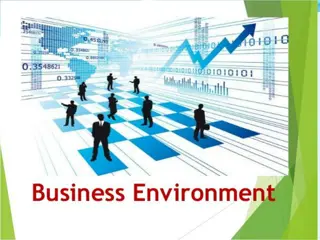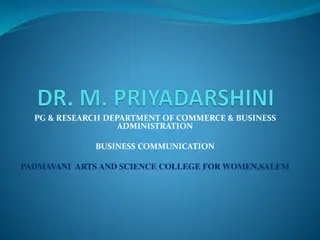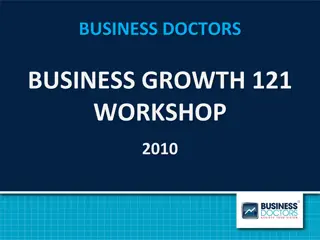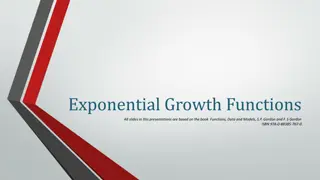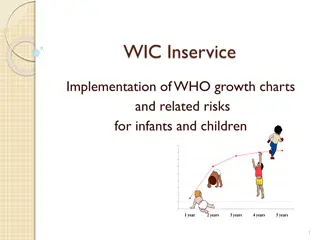Growth Strategies for Business Success
Explore various growth and survival strategies for businesses, including vertical and horizontal growth, overcoming scarcity of funds, factors affecting organizational growth, and advantages and limitations of business expansion. Learn about different growth strategies such as intensive growth, diversification, mergers, and modernization to achieve market penetration and development. Discover how businesses can navigate challenges and leverage opportunities to sustain and expand their operations effectively.
Download Presentation

Please find below an Image/Link to download the presentation.
The content on the website is provided AS IS for your information and personal use only. It may not be sold, licensed, or shared on other websites without obtaining consent from the author.If you encounter any issues during the download, it is possible that the publisher has removed the file from their server.
You are allowed to download the files provided on this website for personal or commercial use, subject to the condition that they are used lawfully. All files are the property of their respective owners.
The content on the website is provided AS IS for your information and personal use only. It may not be sold, licensed, or shared on other websites without obtaining consent from the author.
E N D
Presentation Transcript
GROWTH AND SURVIVAL STRATEGIES
GROWTH STRATEGIES Business growth means an increase in the size or scale of operations of a firm usually accompanied by increase in its resources and output. Growth strategy is a corporate level strategy, design to achieve increase in sales, assets and profits. Growth strategies may be classified as follows: 1. Vertical growth 2. Horizontal growth
Scarcity of funds Deciding to grow and Planning for growth Marketing Risk Technology
NEED FOR GROWTH OF BUSINESS ORGANIZATION OR FACTORS AFFECTING GROWTH OF ORGANIZATION Survival Self- Economies of scale sufficiency Government policy Owner s mandate Prestige and power Expansion of the market Latest technology
FACTORS THAT AFFECT THE WORKING OF BUSINESS ORGANIZATION: Demand and Supply Money and Banking Trade cycles Economic Growth and Development General price level Income and Employment
ADVANTAGES OF GROWING ORGANIZATION Facing competition in the market by diversifying the product line Providing protection against adverse business conditions. e.g. Depression Exploitation of business opportunities Obtaining the economies of scale Raising profits and creating resources for further reinvestment into business Securing subsidies, tax concession and other incentives offered by the government Making optimum utilization of resources Gaining economic and market power
LIMITATIONS OF GROWING ORGANIZATION Finance Market Human Relations problems Management Lack of knowledge Social problems
DIFFERENT GROWTH STRATEGIES Intensive Growth Strategy (Expansion) Diversification External Growth Strategies (a) Mergers (b) Joint Ventures Modernization
INTENSIVE GROWTH STRATEGIES Market penetration Product Development Market Development
ADVANTAGES OF INTENSIVE GROWTH STRATEGY Growth is slow and natural. Capital required for expansion can be taken from the firm s own funds. Existing resources can be better utilized. The growing firm is in a better position to face competition in the market. Only a few changes are required in the organization and management systems of business. Expansion provides economics of large-scale operations.
LIMITATIONS OF INTENSIVE GROWTH STRATEGY Growth is very slow and it takes a long time for growth to actually happen. A business firm loses the possibility of exploiting many business opportunities by restricting its operations to be present products and markets. It is not always possible to grow in the present product market. Practical problems of Intensive Growth Strategy.
ANSOFF MATRIX Existing products New products New markets Existing markets Market Penetration Product Development Market Development Diversification
DIVERSIFICATION A firm may choose the strategy of diversification under the following situations: 1. When diversification promises greater profitability than expansion. 2. When the firm cannot attain it s growth target by the strategy of expansion alone. 3. When the financial resources of the firm are much in excess of the requirements of expansion. 4. When they need to achieve Economies of scale and scope (Synergy).
ADVANTAGES OF DIVERSIFICATION Better use of its resources. Reduce the decline in sales. More competitive with greater resources, more products and higher profits, the diversified firm is more competitive than a single product firm. Minimize risk. Use of cash surplus of one business to finance another business having good potential for growth. Economies of scale Diversification adds to size of business which improves the competitives of a firm.
LIMITATIONS OF DIVERSIFICATION Huge funds are required for diversification. The functions and responsibilities of top executives increase because of need to handle new product, technology and markets. Diversification may involve new technology and new markets and the present staff may face problems in adjusting to this growth pattern. Diversification may lead to unknown products and markets leading to more risk.
TYPES OF DIVERSIFICATION Horizontal Integration Vertical Integration Concentric Conglomerate
HORIZONTAL INTEGRATION It involves addition of parallel new products to the existing product line. This may happen internally or externally, internally a company may decide to enter a parallel product market in addition to the existing product line. Externally, a company combines with a competing firm. The following are some benefits of horizontal integration: 1. Economies of scale-achieved by selling more of the same product. 2. Economies of scope achieved by sharing resources common to different products. 3. Increased bargaining power over suppliers and downstream channel members. 4. Reduction in the cost of global operations made possible by operating plants in foreign markets. 5. Synergy achieved by using the same brand name to promote multiple products.
ADVANTAGES Wasteful competition among the combining firms is removed. It provides economies of large-scale production and distribution. It provides better control over the market and increases the competitiveness of the company. The firm gets better control over supply and prices of the product.
DISADVANTAGES The firm is not confident of supply of raw materials. If many firms combine to form horizontal integration, there is a risk of over- capitilisation. The management of the firm may become bureaucratic and inflexible. The firm may acquire exploit consumers and labour by becoming a monopoly.
VERTICAL INTEGRATION In vertical integration new products or services are added which are complementary to the present product line or service. Vertical integration may be of two types:- Vertical Integration Forward Integration Backward Integration
FORWARD INTEGRATION Forward integration means the firm entering into the business of distributing or selling its present products. It refers to moving upwards in the production/distribution process towards the ultimate consumer. The firm sets up its own retail outlets for the sale of its own products.
ADVANTAGES The firm can exercise greater control over sales and prices of its product. The firm s own retail stores serve as better source of customer feedback. The firm can improve its profits by reducing the costs of distribution and the costs of middlemen. The firm can secure the economies of integration.
DISADVANTAGES The proportion of fixed costs in the firm s costs increases. Since its processes are interdependent, a slight interruption in one process may dislocate the entire production system. In the absence of proper balance between up-stream and down-stream units, the firm has to buy from or sell in the open market. It is very difficult to efficiently manage an integrated firm because every business has its own structure, technology and problems.
BACKWARD INTEGRATION - ADVANTAGES It involves moving toward the input of the present product. It is aimed at moving lower on the production process so that the firm is able to supply its own raw materials or basic components. Regular supply High return on investment Tax saving Advantages Bargaining power Competitive ness Quality control
DISADVANTAGES If an existing input producing unit is taken over, it may involve large investment. By investing heavily in backward integration the developments of the final products nay get hampered. In the absence of backward integration the firm may purchase at a lower cost from technically more efficient suppliers. Any adverse changes in the economy affecting the present product market will also affect adversely the production of inputs. When the divisions using the inputs do not have the freedom of comparing market conditions of supply, the problem of transfer pricing may become acute.
CONCENTRIC DIVERSIFICATION OR RELATED DIVERSIFICATION When a firm diversifies into some business which is related with its present business in terms of marketing, technology, or both, it is called concentric diversification. When in concentric diversification new product or service is provided with the help of existing or similar technology it is called technology-related concentric diversification. Concentric diversification is suitable for the following purposes: 1. When cyclical fluctuations in the present products or services are to be counteracted 2. When the cash flows generated by the existing products or services are in surplus. 3. When demand for present products or services has reached saturation point. 4. To gain managerial expertise in new field of business. 5. When reputation of present products or services is high and can be used for new products or service.
CONGLOMERATE DIVERSIFICATION OR UNRELATED DIVERSIFICATION When a firm diversifies into business which is not related to its existing business both in terms of marketing and technology it is called conglomerate diversification. Conglomerate diversification strategy is suitable for the following purposes: 1. To grow faster than the growth realised through expansion. 2. To avail of potential opportunities for profitable investment. 3. To achieve competitive edge and greater stability. 4. To make better use of cash surplus of present products or services. 5. To allocate the risks.
MODERNIZATION Modernization basically involves up gradation of technology to increase production, to improve quality and to reduce wastages and cost of production. Modernization plans implications: 1. A firm may go for modernization at a low pace to maintain its position in the market. 2. Modernization may be used with full strength to achieve internal growth.
ADVANTAGES Modernization improves the productivity and efficiency of the firm. The profitability of the firm goes up because of increased efficiency and reduced wastages. It makes available better quality products to the customers. The firm becomes more competitive in the long-run because of modernization. The growth is systematic and does not affect the normal functioning of the firm.
LIMITATIONS The accumulated savings of the business may not be sufficient to finance modernization of plant and machinery. The responsibilities of top executives would increase because of need to handle new product, technology and markets. The existing staff may face problems in adapting to the new technology.
EXTERNAL GROWTH STRATEGIES Merger is an external growth strategy. When different companies combine together into new corporate organization, such a process is known as mergers. Mergers and Acquisition: Advantages A merger provides economies of large-scale operations. Better utilization of funds can be made to increase profits. There is possibility of diversification. More efficient use of resources can be made. Sick firms can be rehabilitated by merging them with strong and efficient concerns.
DISADVANTAGES The combined enterprise may be unwieldy. Effective co-ordination and control become difficult. Mergers give rise to monopoly and concentration of economic power which often operate against the interest of the society and the country. Guidelines for successful Mergers: Identify the merger objectives, especially economic objectives. Specify gains for the shareholders of both the joining companies Be convinced that the acquired company management is or can be made competent. Report the existence of important dovetailing resources; but do not expect perfect compatibility. Start the process of merger with active involvement of the top executives. Define clearly the business that the company is in. Analyse and identify the strengths, weaknesses and key performance factors for both the combining units. Foresee possible problem and discuss them at the initial stage with the other company so as to create a climate of trust. Don t threaten the management to be acquired. Human consideration should be of prime importance in planning for merger and designing the organization structure for the new set up.
SYNERGY Staff Acquiring new technology reductions Economies of scale
Takeovers or Acquisition The term acquisition is another ambiguous term. At the most general, it means an attempts by one firm, called the acquiring firm to gain a majority interest in another firm called the target firm. When two or more firms mutually decide to establish a new enterprise by participating in equity capital and in business operations it is known as joint venture. Joint Ventures
SURVIVAL STRATEGIES Liquidation Divestment Spin-off






